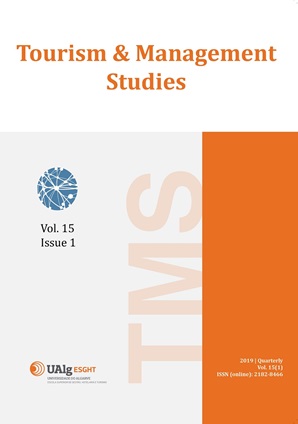Challenges in linking destinations’ online reputation with competitiveness
DOI:
https://doi.org/10.18089/tms.2019.150103Abstract
This study sought to examine how Web 2.0 conversations in social media platforms impact destinations’ reputation and how co-creation practices influence this process. The five most competitive destinations worldwide were included in the research. The results demonstrate that monitoring social media is a challenge in tourism but also a strategic tool to support decision-making processes and sustainable destination brand building. Various monitoring and analytic tools are currently available, but more models are needed to systematise and harness social media data for destination management organisations. The findings include tourists’ central role in destinations’ competitiveness through these visitors’ online posts about experiences and opinions, as well as key strategies for successful social media management based on this study’s results.
References
Abbate, T., & Coppolino, R. (2013). Open Innovation and online intermediaries: A review theory and its implications for tourism. International Conference Marketing from Information to Decision, Department of Marketing (pp. 9-22), Faculty of Economics and Business, Babes-Bolyai University, Cluj Napoca.
Boo, S., Busser, J., & Baloglu, S. (2009). A model of customer-based brand equity and its application to multiple destinations. Tourism Management, 30(2), 219-231.
Buhalis, D. (2000). Marketing the competitive destination of the future. Tourism Management, 21(1), 97-116.
Buffaa, F., Beritellib, P.,& Martinia, U. (2018). Project networks and the reputation network in a community destination: Proof of the missing link. Journal of Destination Marketing and Management. (in press).
Buonincontri, P., & Micera, R. (2016). The co-creation experience in smart tourism destinations: a multiple case analysis of European destinations. Information Technology & Tourism, 16(3), 285-315.
Chan, H. (2007). Linkage community-based innovation and speed to market: then mediating role of new product development process. International Journal of Organizational Innovation, 2(4), 49-60. Chen, J. K., & Chen, I. S. (2009). Fuzzy integral and fuzzy measure methods for the reputation performance of the leisure service industry. Business Renaissance Quarterly, 4(2), 85-105. Chesbrough, H. (2003). Open Innovation. The new imperative for creating and profiting from technology. Boston: Harvard Business School Press. Chiaroni, D., Chiesa, V., & Frattini, F. (2011). The Open Innovation Journey: How firms dynamically implement the emerging innovation management paradigm. Technovation, 31(1), 34-43.
Coca-Stefaniak, A. (2014). Place branding and city centre management: Exploring international parallels in research and practice. Journal of Urban Regeneration & Renewal, 7(4), 363-369.
De Ascaniis, S., & Gretzel, U. (2013). Communicative functions of Online Travel Review titles: a pragmatic and linguistic investigation of destination and attraction OTR titles. Studies in Communication Sciences, 13(2), 156-165.
Freire, J. R. (2011). Destination brands: Managing place reputation (3rd edition). Place Branding and Public Diplomacy, 7(4), 316-320. Füller, J., Mühlbacher, H., Matzler, K., & Jawecki, G. (2009). Customer empowerment through Internet-based co-creation. Journal of Management Information Systems, 26(3), 71–102.
Hassan, S. (2000). Determinants of market competitiveness in an environmentally sustainable tourism industry. Journal of Travel Research, 38(3), 239-245.
Huang-Horowitz, N. C. (2016). The Media Reputation of Small Firms: Exploring the Applicability of Existing Reputation Measures. Corporate Reputation Review, 19(2), 127-139.
Huizingh, E. (2011). Open innovation: State of the art and future perspectives. Technovation, 1(31), 2-9
Iglesias-Sánchez, P. P., Correia, M. B., Jambrino-Maldonado, C., & Luque-Rojas, D. (2017). Retos en la gestión de destinos turísticos a partir de la innovación abierta. Estudios y Perspectivas en Turismo, 26(3), 531-548.
Inversini, A., Marchiori, E., Dedekind, C., & Cantoni, L. (2010). Applying a conceptual framework to analyse online reputation of tourism destinations. Information and Communication Technologies in Tourism, 20, 321-332.
Karlsson, M. (2010). Collaborative idea management: Using the creativity of crowds to drive innovation. Innovation Management, 1, 3-27.
Komsic, J., & Dorcic, J. (2016). Tourism destination competitiveness and online reputation: conceptualization and literature framework analysis. Faculty of Tourism and Hospitality Management in Opatija. Biennial International Congress. Tourism & Hospitality Industry, 144-157.
Ledesma, F. J., Navarro, M., & Perez-Rodriguez, J. (2005). Return to tourist destination. Is it reputation, after all? Applied Economics, 37(18), 2055-2065.
Micera, R., & Crispino, R., (2017). Destination web reputation as "smart tool" for image building: The case analysis of Naples city-destination. International Journal of Tourism Cities, 3(4), 406-423.
Moorman, C., Zaltman, G., & Desphande, R. (1992). Relationship between providers and users of market research: The dynamics of trust within and between organizations. Journal of Marketing Research, 29(3), 314–328.
Morgan, N., Pritchard, A., & Pride, R. (2013). Destination Brands Managing Place Reputation. Amsterdam: Elsevier.
Ritchie, J.R.B., & Crouch, G.I. (2003). The Competitive Destination: A Sustainable Tourism Prospective, CABI Publishing. Roeffen, D., & Scholl-Grissemann, U. (2016). The importance of customer co-creation of value for the tourism and hospitality industry. In Egger R., Gula I., Walcher D. (eds), Open Tourism. Tourism on the Verge (pp. 35-46). Berlin–Heidelberg: Springer.
Shankar, A., Cherrier, H., & Canniford, R. (2006). Consumer empowerment: A Foucauldian interpretation. European Journal of Marketing, 4(9–10), 1013–1030.
Weiermair, K. (2006). Product improvement or innovation: what is the key to success in tourism? In OECD, Innovation and growth in tourism (pp. 53-69), Paris.
World Economic Forum. (2017). The Travel & Tourism Competitiveness Report 2017. Retrieved March 23, 2018, from https://www.weforum.org/reports/the-travel-tourism-competitiveness-report-2017
UNWTO (2017) Tourism Highlights: 2017 Edition. Retrieved March 23, 2018, from http://mkt.unwto.org/publication/unwto-tourism-highlights
Downloads
Published
Issue
Section
License
Copyright (c) 2019 Tourism & Management Studies

This work is licensed under a Creative Commons Attribution-NoDerivatives 4.0 International License.
The journal retains published articles’ copyrights, but they are simultaneously licensed under the Creative Commons Attribution License (CC BY-NC-ND), which allows individuals’ to share the relevant papers as long as authorship and publication in this journal are duly acknowledged.



